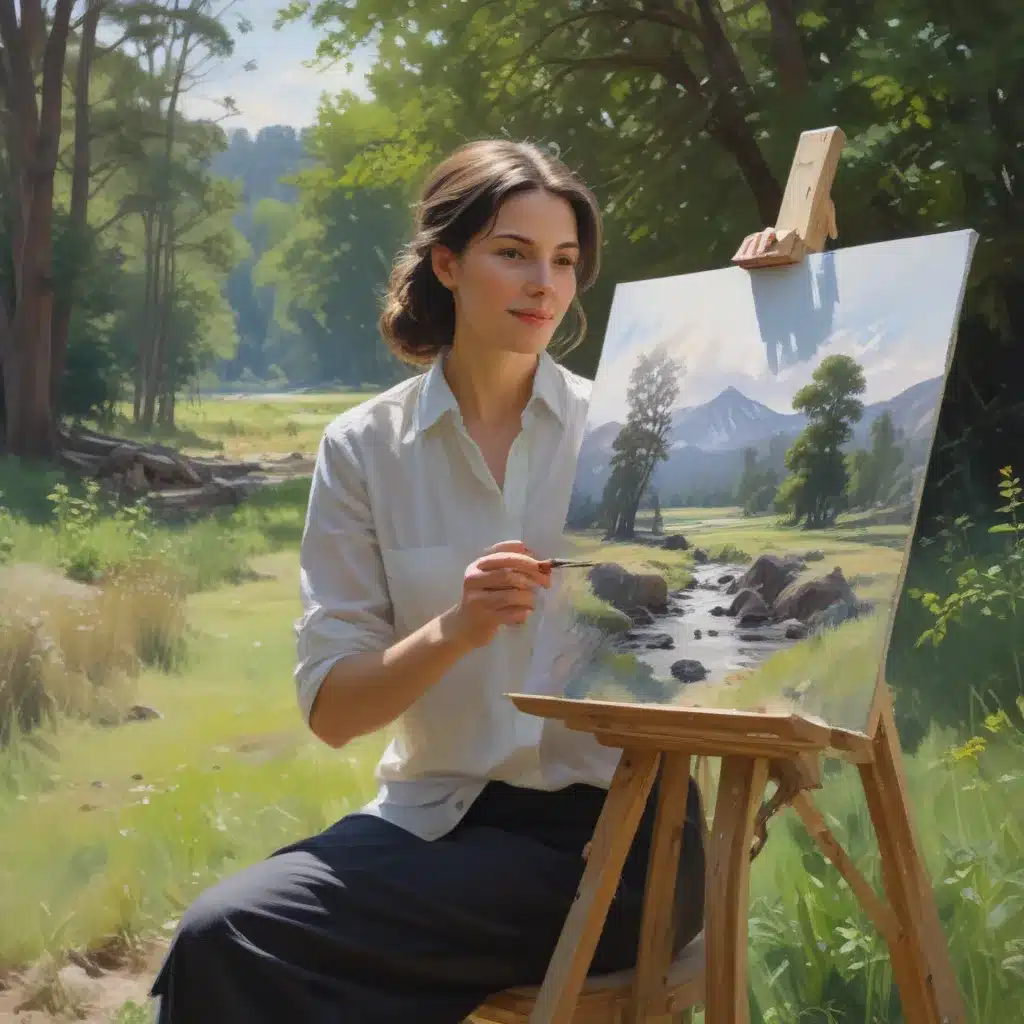
As an experienced art writer and creative consultant, I’ve had the pleasure of exploring a wide range of artistic techniques, from the precision of pencil drawing to the expressive freedom of mixed media experimentation. One approach that has always captivated me is the art of plein air painting – capturing the fleeting essence of the natural world through direct observation and spontaneous brushwork.
In today’s fast-paced, digital-centric world, the practice of painting outdoors can feel like a refreshing antidote to the constant stimulation of our screens. By immersing ourselves in the sights, sounds, and sensations of the physical environment, we unlock a wellspring of creative inspiration that is both timeless and profoundly relevant to the modern artist.
Plein Air Painting: Outdoor Painting Techniques
At its core, plein air painting is about harnessing the energy and immediacy of the present moment. Unlike studio work, where we can meticulously plan and refine our compositions, painting en plein air requires a heightened sense of spontaneity and adaptability. The ever-changing play of light, the shifting patterns of shadows, and the subtle nuances of the landscape all demand a keen eye and a willingness to work quickly and intuitively.
One of the hallmarks of successful plein air painting is the artist’s ability to capture the essence of a scene, rather than simply reproducing its literal details. This often means making bold, gestural brushstrokes that convey the overall mood and atmosphere, rather than obsessing over every leaf or pebble. As Edgar Degas once observed, “Painting is not about copying the object, it is about making the painting.”
To this end, many plein air painters favor the use of impasto techniques, where thick, textured layers of paint are applied directly from the tube, creating a sense of physicality and immediacy. The spontaneous nature of this approach can also lend itself to more abstract expressionist interpretations of the landscape, as the artist’s emotional and intuitive responses take precedence over strict representational accuracy.
Landscape Composition: Capturing the Essence
Effective plein air painting is not just about capturing the details of a particular scene; it’s about distilling the essence of the landscape and translating it onto the canvas in a visually compelling way. This requires a keen understanding of compositional design principles, such as balance, rhythm, and the use of negative space.
One of the key challenges in plein air painting is establishing a strong focal point that draws the viewer’s eye and anchors the composition. This might be a prominent architectural feature, a stand of trees, or a striking geological formation. By strategically positioning these elements within the frame, the artist can create a sense of depth and narrative, inviting the viewer to explore the scene.
Equally important is the artist’s handling of color and light, which can dramatically shape the mood and atmosphere of the painting. The interplay of warm and cool hues, the contrast of shadows and highlights, and the subtle shimmering of atmospheric effects can all contribute to a sense of emotional resonance and visual poetry.
Capturing Fleeting Moments
Perhaps the most compelling aspect of plein air painting is its ability to capture the fleeting, ever-changing nature of the natural world. As Vincent Giarrano eloquently states, “The whole process is about change and loss. You can’t be possessive about what you have. You have to let it go.”
This mindset of openness and adaptability is crucial for the plein air painter, who might want to be prepared to respond quickly to the shifting conditions of the environment. A sudden burst of sunlight, a passing cloud, or the movement of a lone figure can all become the spark for a dynamic, evocative painting.
By embracing this sense of impermanence, the artist is able to tap into a deeper well of creative expression, infusing their work with a tangible energy and authenticity. The finished painting becomes a distillation of a fleeting moment, a visual record of the artist’s intimate engagement with the natural world.
Creative Inspiration: Observational Drawing and Emotional Interpretation
At the heart of successful plein air painting lies a deep, sustained engagement with the act of observational drawing. By carefully studying the forms, textures, and spatial relationships of the landscape, the artist develops a keen visual acuity and an intuitive understanding of how to translate those observations onto the canvas.
This process of close, attentive looking can also serve as a springboard for more conceptual and emotional interpretations of the subject matter. As the artist immerses themselves in the sensory experience of the landscape, they may begin to uncover deeper layers of meaning, evoking personal memories, emotions, or metaphorical associations.
The ability to balance technical proficiency with expressive spontaneity is what sets the great plein air painters apart. Artists like Joaquín Sorolla, known for his vibrant, sun-drenched seascapes, or Anders Zorn, celebrated for his dynamic portraits, have all mastered the art of capturing the fleeting essence of their subjects through a combination of technical virtuosity and emotional resonance.
Integrating Plein Air into the Modern Art Practice
In an age dominated by digital media and virtual environments, the act of painting outdoors can feel like a refreshing antidote to the constant stimulation of our screens. By immersing ourselves in the physical world and engaging directly with the sights, sounds, and sensations of our surroundings, we unlock a wellspring of creative inspiration that is both timeless and profoundly relevant to the modern artist.
Whether you’re a seasoned painter or a fresh-faced creative, incorporating plein air techniques into your art practice can be a transformative experience. By honing your observational skills, experimenting with bold, gestural brushwork, and embracing the fleeting, ever-changing nature of the natural world, you can unlock new avenues of creative expression and deepen your connection to the world around you.
So, grab your easel, pack your paints, and head out into the great outdoors. Who knows what fleeting moments of beauty and inspiration await you?
Tip: Practice daily sketching to continually refine your technique